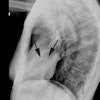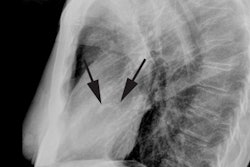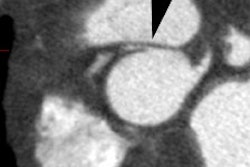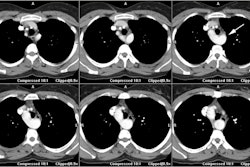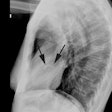Sinus of Valsalva Aneurysm:
Clinical:
Sinus of Valsalva aneurysms are rare lesions that may be congenital (most commonly) or acquired, however, most cases do not present until adulthood. Males are affected more than females (4:1) [4]. The incidence among patients undergoing cardiopulmonary bypass is 0.1% to 1.5% [3]. Unruptured aneurysms are usually asymptomatic and are discovered incidentally. Rarely, an aneurysm may compress an adjacent coronary artery and produce ischemic symptoms. Even following rupture (which most commonly occurs in the 3rd or 4th decade of life [4]) patients may remain asymptomatic, but CHF and sudden death can occur [2]. Although the lesion is usually an isolated anomaly, it may be associated with ventriuclar setal defect (30-60% of patients [5]), aortic regurgitation/insufficiency (20-30%), bicuspid aortic valve (10%), and less frequently coronary anomalies [4,5]. Right coronary Valsalva sinus aneurysms are associated with supracristal (type I) VSD's (infracristal, or type II VSD's are more common in patients with an otherwise healthy heart) [5].
The aneurysm is thought to arise from incomplete fusion of the distal bulbar septum that divides the aorta and pulmonary artery and attaches to the annulus fibrosis of the aortic valve [4]. It is postulated that after exposure to longstanding high pressures, this area, which forms part of the sinuses of Valsalva, weakens and becomes aneurysmal [4]. Another proposed etiology is that they result from a fundamental localized weakness of the elastic lamina at the junction of the aortic media and annulus fibrosis [4].
Aneurysms most commonly involve the right coronary sinus (67-90%), the non-coronary sinus (10-25%), and the left coronary sinus (3-6%) [4,5]. The left sinus is rarely affected by congenital lesions because it does not arise from the bulbar septum [4]. The most common clinical findings are a cardiac murmur (57% of cases) and dyspnea (56% of cases) [5]. If ruptured, symptoms can vary depending on the size of the aneurysms and site of communication and include severe dyspnea, chest pain, hemodynamic compromise or insidious CHF, and volume overload [5]. Aortic regurge is a common complication of both ruptured and non-ruptured Valsalva sinus aneurysms and occurs in 30-50% of patients [5].
Rupture typically results in communication between the sinus and the right side of the heart- producing an acute right-to-left shunt. This is because the sinuses are largely intracardiac- with the right and non-coronary sinuses encompassed by the right ventricle and atrium, respectively. Right sinus rupture typically communicates with the right ventricle, while rupture of the non-coronary sinus will result in communication with the right atrium [4]. Rupture into the left ventricle is extremely rare [3]. Small and moderate sized unruptured aneurysms can be followed medically, but larger and ruptured lesions require surgical repair with cardiopulmonary bypass surgery [5].
Secondary causes of sinus of Valsalva aneurysms are less common and more frequently affect the left sinus [4]. Secondary cause include bacterial endocarditis, trauma/iatrogenic (following valve replacement), syphilis, TB, atherosclerosis, cystic medial necrosis, and Bechet disease [4,5].
The sinus of Valsalva aneurysm is not generally apparent on chest radiograph- although it may occasionally manifest as an abnormal convexity of the upper right heart border. Rupture may result in cardiac enlargement and pulmonary venous congestion [4]. CT and MR imaging can both demonstrate the aneurysm. The criteria for diagnosing a Valsalva sinus aneurysm include an origin above the aortic annulus, a saccular shape, and normal dimensions of the adjacent aortic root and ascending aorta [5].
REFERENCES:
(1) AJR 1996; Chest case of the day. Rupture of a sinus of Valsalva aneurysm into the right ventricle. 167: p. 236-237 (No abstract available)
(2) J Cardiovasc Surg 1994; Isomura T, et al. Ruptured aneuysms of the sinus of valsalva. 35: 135-138
(3) J Am Soc Echocardiogr 1997; Kucukoglu S, et al. Ruptured aneurysm of the sinus of valsalva.
(4) Radiology 2001; White CS, Plotnick GD. Case 33: Sinus of valsalva aneurysm. 219: 82-85 (No abstract available)
(5) Radiographics 2010; Bricker AO, et al. Valsalva sinus aneurysms: findings at CT and MR imaging. 30: 99-110
